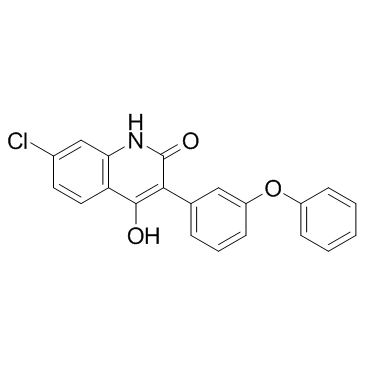L 701324

L 701324 structure
|
Common Name | L 701324 | ||
|---|---|---|---|---|
| CAS Number | 142326-59-8 | Molecular Weight | 363.794 | |
| Density | 1.4±0.1 g/cm3 | Boiling Point | 584.7±50.0 °C at 760 mmHg | |
| Molecular Formula | C21H14ClNO3 | Melting Point | N/A | |
| MSDS | Chinese USA | Flash Point | 307.4±30.1 °C | |
| Symbol |

GHS07 |
Signal Word | Warning | |
Use of L 701324L-701324 is an orally active and long acting anticonvulsant with high affinity and selectivity for the glycine site on the NMDA receptor.Target: NMDA ReceptorL-701324 is a potent, active anticonvulsant with a reduced propensity to activate mesolimbic dopaminergic systems in rodents. L-701324 exhibits a beneficial action in the animal model of parkinsonian rigidity, but not that of parkinsonian akinesia. L-701324 (2.5-40 mg/kg, i.p.) dose-dependently decreased the muscle tone enhanced by haloperidol (1-5 mg/kg, i.p.). |
| Name | 7-chloro-4-hydroxy-3-(3-phenoxyphenyl)-1H-quinolin-2-one |
|---|---|
| Synonym | More Synonyms |
| Description | L-701324 is an orally active and long acting anticonvulsant with high affinity and selectivity for the glycine site on the NMDA receptor.Target: NMDA ReceptorL-701324 is a potent, active anticonvulsant with a reduced propensity to activate mesolimbic dopaminergic systems in rodents. L-701324 exhibits a beneficial action in the animal model of parkinsonian rigidity, but not that of parkinsonian akinesia. L-701324 (2.5-40 mg/kg, i.p.) dose-dependently decreased the muscle tone enhanced by haloperidol (1-5 mg/kg, i.p.). |
|---|---|
| Related Catalog | |
| References |
| Density | 1.4±0.1 g/cm3 |
|---|---|
| Boiling Point | 584.7±50.0 °C at 760 mmHg |
| Molecular Formula | C21H14ClNO3 |
| Molecular Weight | 363.794 |
| Flash Point | 307.4±30.1 °C |
| Exact Mass | 363.066223 |
| PSA | 62.32000 |
| LogP | 5.50 |
| Vapour Pressure | 0.0±1.7 mmHg at 25°C |
| Index of Refraction | 1.680 |
| Storage condition | 2-8℃ |
| Symbol |

GHS07 |
|---|---|
| Signal Word | Warning |
| Hazard Statements | H315-H319-H335 |
| Precautionary Statements | P261-P305 + P351 + P338 |
| Personal Protective Equipment | dust mask type N95 (US);Eyeshields;Gloves |
| Hazard Codes | Xi |
| Risk Phrases | R36/37/38 |
| Safety Phrases | S26 |
| RIDADR | NONH for all modes of transport |
|
NMDA/glutamate mechanism of magnesium-induced anxiolytic-like behavior in mice.
Pharmacol. Rep. 60(5) , 655-63, (2008) The anxiolytic-like activity of magnesium in mice during the elevated plus maze (EPM) has been demonstrated previously. In the present study, we examined the involvement of NMDA/glutamate receptor lig... |
|
|
NMDA/glutamate mechanism of antidepressant-like action of magnesium in forced swim test in mice.
Pharmacol. Biochem. Behav. 88(2) , 158-64, (2007) Antidepressant-like activity of magnesium in forced swim test (FST) was demonstrated previously. Also, enhancement of such activity by joint administration of magnesium and antidepressants was shown. ... |
|
|
Activation of the NMDA/glutamate receptor complex antagonizes the NMDA antagonist-induced antidepressant-like effects in the forced swim test.
Pharmacol. Rep. 59(5) , 595-600, (2007) The antidepressant activity of NMDA receptor antagonists has been demonstrated, and their mechanism of action was based on the assumption of their selectivity for the NMDA receptor only. However, no d... |
| 7-chloro-3-(3-phenoxyphenyl)quinoline-2,4-diol |
| Sulprostone |
| 2(1H)-Quinolinone, 7-chloro-4-hydroxy-3-(3-phenoxyphenyl)- |
| 2,4-quinolinediol, 7-chloro-3-(3-phenoxyphenyl)- |
| 7-Chloro-4-hydroxy-3-(3-phenoxyphenyl)-2(1H)-quinolinone |
| 7-Chloro-4-hydroxy-3-(3-phenoxyphenyl)quinolin-2(1H)-one |
| L-701,324 |
| L-701324 |